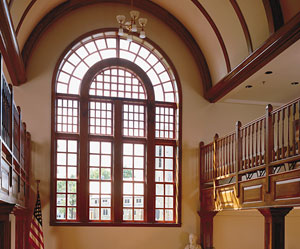Window Replacement Solutions for Commercial and Institutional Buildings
Beyond the previously mentioned scenarios, buildings can be determined to be "non historic" and, if they were built before 1936, may still be eligible for a 10% tax credit provided they meet the following criteria:
- Building cannot be listed in:
- National Register of Historic Places
- National Register listed historic district
- Certified State or local historic district
- Must be rehabilitated for non-residential use
Under this scenario, there is no formal review process by National Park Service.
 |
Wirtz Building, Chicago, IL - Window replacement Photo courtesy of Pella Corporation |
For all other buildings, and the most common scenario involving window replacement, renovations or rehabilitation work is simply undertaken as a building project with the following characteristics:
- No tax credits are being pursued or they are not applicable
- The building is not subject to review by NPS or SHPO
- The architect and owner review and select the best option available for window related work.
Window Rehabilitation Guidelines and Planning
Looking more specifically at windows as historic features, they are usually considered significant when they are original to the building.
However, they can also be important if they were changed within a time period of significance, if they demonstrate exceptional craftsmanship or design, or if they contribute notably to the historic character of the property. Hence, windows will need to be looked at under these criteria to determine whether repair or replacement is the preferred option. In making that assessment, the basic options include the following:
-
Identify / Retain / Preserve - following a field survey and identification of the existing windows, the first option to consider is whether or not some or all of the windows will be retained and preserved with little or no additional work.
Winchester Town Hall, Boston, MA - Interior of replacement windows
Photo courtesy of Pella Corporation
- Protect and Maintain - some windows may require some basic attention at the maintenance level in order to protect them from deterioration and remain fully functional.
- Repair - other windows may have broken pieces or elements that require functional repair of that damage. Repairs should always be carried out with the intention of matching the existing elements as closely as possible or practical for general aesthetic and operational needs in addition to any historic concerns.
- Replace - when none of the above are truly feasible, then the windows need to be considered for replacement. In doing so, using the following criteria can be useful since any one of them may be appropriate justification to replace rather than repair a window:
- Deterioration is too severe to effectively repair - i.e. the existing elements of the windows are not in tact enough to assure that the repairs will be long lasting.
- The historic character of the buildings is not based on the windows hence, their replacement will not detract from that character.
- Cost of repair vs. replacement - labor intensive repairs may cost considerably more than a purchased replacement window while the replacement may perform much better over the life of the building.
- Ease of operation for operable windows or adding operability to non-opening windows is important to indoor air quality in buildings and user satisfaction.
- Hazard abatement including lead based paint or asbestos based material is more appropriately performed by removing and replacing the entire window rather than just the subject materials.









